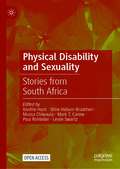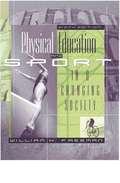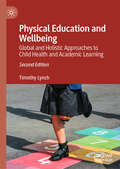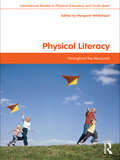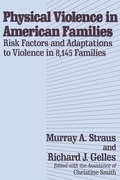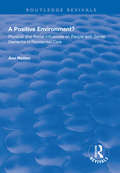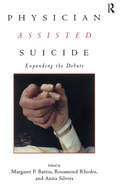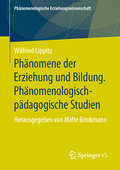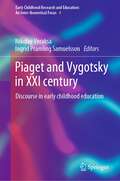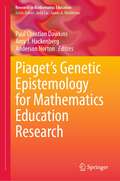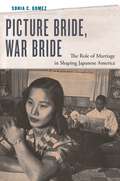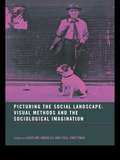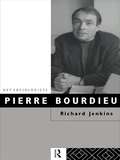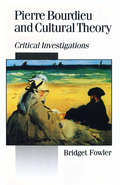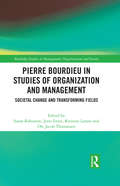- Table View
- List View
Physical Disability and Sexuality: Stories from South Africa
by Leslie Swartz Poul Rohleder Xanthe Hunt Stine Hellum Braathen Mussa Chiwaula Mark T. CarewThis open access edited volume explores physical disability and sexuality in South Africa, drawing on past studies, new research conducted by the editors, and first-person narratives from people with physical disabilities in the country. Sexuality has long been a site of oppression and discrimination for people with disabilities based on myths and misconceptions, and this book explores how these play out for people with physical disabilities in the South African setting. One myth with which the book is centrally concerned, is that people with disabilities are unable to have sex, or are seen as lacking sexuality by society at large. Societal understandings of masculinity, femininity, bodies and attractiveness, often lead people with physical disabilities to be seen as being undesirable romantic or sexual partners. The contributions in this volume explore how these prevailing social conditions impact on the access to sexual and reproductive healthcare, involvement in romantic relationships, childbearing, and sexual citizenship as a whole, of people with physical disabilities in the Western Cape of the country. The authors' research, and first person contributions by people with physical disabilities themselves, suggest that education and public health policy must change, if the sexual and reproductive health rights and full inclusion of people with disabilities are to be achieved.
Physical Education & Sport in a Changing World
by William H. FreemanThis sixth edition of Society examines the developing subdisciplines and interests in the broad field of physical education, sport, exercise science, and kinesiology.
Physical Education and Wellbeing: Global and Holistic Approaches to Child Health and Academic Learning
by Timothy LynchThis book, now in its second edition, explores how physical education (PE) and learning through movement can be best enacted in schools in order to optimise children's wellbeing and subsequent academic learning. Drawing together extensive data from school communities around the globe, the author examines multiple dimensions of child health in practice. Ultimately, the findings suggest that PE is imperative within the wider landscape of children’s holistic learning, offering a powerful platform for meaningful connections across learning areas. While quantitative research has long evidenced the benefits of physical activity, this book contributes to the complex and global issue of what effective health and wellbeing approaches look like in practice, offering clear strategies for optimising children’s academic learning. It is natural for children to enjoy movement for the purposes of play, exploration, learning and development; this book is essential reading for scholars (professors, researchers and students), school leaders and educators looking to enhance children’s wellbeing, general health and academic learning.
Physical Evidence for Ritual Acts, Sorcery and Witchcraft in Christian Britain: A Feeling for Magic (Palgrave Historical Studies in Witchcraft and Magic)
by Ronald HuttonPhysical Evidence for Ritual Acts, Sorcery and Witchcraft in Christian Britain.
Physical Literacy: Throughout the Lifecourse (Routledge Studies in Physical Education and Youth Sport)
by Margaret WhiteheadWhat is physical literacy? What are the benefits of being physically literate? The term ‘physical literacy’ describes the motivation, confidence, physical competence, understanding and knowledge that individuals develop in order to maintain physical activity at an appropriate level throughout their life. Physical literacy encompasses far more than physical education in schools or structured sporting activities, offering instead a broader conception of physical activity, unrelated to ability. Through the use of particular pedagogies and the adoption of new modes of thinking, physical literacy promises more realistic models of physical competence and physical activity for a wider population, offering opportunities for everyone to become active and motivated participants. This is the first book to fully explore the meaning and significance of this important and emerging concept, and also the first book to apply the concept to physical activity across the lifecourse, from infancy to old age. Physical Literacy – explaining the philosophical rationale behind the concept and also including contributions from leading thinkers, educationalists and practitioners – is essential reading for all students and professionals working in physical education, all areas of sport and exercise, and health.
Physical Violence in American Families: Risk Factors And Adaptations To Violence In 8,145 Families
by Murray StrausThe informative and controversial findings in this book are based on two path-breaking national surveys of American families. Both show that while the family may be the central locus of love and support, it is also the locus of risk for those who are physically assaulted. The book provides a wealth of information on gender differences and similarities in violence, and on the effects of gender roles and inequality.Two landmark American studies of violence from the National Family Violence survey form the basis of this book. Both show that while the family may be the central locus of love and support, it is also the locus of risk for those who are being physically assaulted. This is particularly true for women and children, who are statistically more at risk of assault in their own homes than on the streets of any American city. Physical Violence in American Families provides a wealth of information on gender differences and similarities in violence, and on the effects of gender roles and inequality. It is essential for anyone doing empirical research or clinical assessment.
Physical and Social Influences on People with Senile Dementia in Residential Care: Physical and Social Influences on People with Senile Dementia in Residential Care (Routledge Revivals)
by Ann NettenPublished in 1993. The Increasing numbers of very elderly people in the population and the decreased use of long-stay hospitals are leading to pressure for services in the community for people with dementia. Residential care plays an important role in the care of such people, and developing new, innovative services and monitoring the quality of care in existing institutions are important policy issues. The book describes an investigation into the relationship between the residential care environment and the welfare of residents with senile dementia. Unlike many studies of residential care, the study included aspects of both the physical and social environment and examined the impact on residents over time. The study used some innovative approaches to assessing the impact of the environment of residents and the book describes a model using quantitative techniques to analyse outcomes for residents. The policy issues and provide pointers for specifying standards for the care of residents with senile dementia. The potential for innovative schemes building on the results of the study is discussed, and the concept of ‘informal care homes’ is introduced.
Physician Assisted Suicide: Expanding the Debate (Reflective Bioethics)
by Anita Silvers Rosamond Rhodes Margaret P. BattinPhysician Assisted Suicide is a cross-disciplinary collection of essays from philosophers, physicians, theologians, social scientists, lawyers and economists. As the first book to consider the implications of the Supreme Court decisions in Washington v. Glucksburg and Vacco v. Quill concerning physician-assisted suicide from a variety of perspectives, this collection advances informed, reflective, vigorous public debate.
Physiological Computing Systems
by Andreas Holzinger Hugo Plácido da Silva Stephen Fairclough Dennis MajoeThis book constitutes the proceedings of the First International Conference on Physiological Computing Systems, PhyCS 2014, held in Lisbon, Portugal, in January 2014. The 10 papers presented in this volume were carefully reviewed and selected from 52 submissions. They are organized in topical sections named: methodologies and methods; devices; applications; and human factors.
Physis, Biopower, and Biothermodynamics: The Fire of Life (ISSN)
by Enrique LeffBuilding upon the idea that our current "environmental question" arises from the history of metaphysics—which privileged thought about Being (or ontology) over the conditions of life—this book reinterprets Heraclitus’s notion of physis as the fundamental, emergent potency of life, as the category to-be-thought by thinkers. In so doing, it deconstructs the interpretation offered by Heidegger and so stresses the struggle between the creative force of life and its subjection to the human Logos or "meaning". Physis, understood as the pre-ontological potentiality of life itself, thus becomes the cornerstone of a materialist philosophy of life.Following engagements with the work of Nietzsche, Foucault, and Janicaud to explore the significance of human intervention into the realm of life via the "will to power", "biopower" and the "power of rationality" respectively, the author explores twentieth-century rearticulations of the concept of physis through a range of developments in biothermodynamics, thus grounding a new philosophy of life and a new bioeconomics in a revisited biothermodynamics centered on the concept of negentropy.An extensive engagement with the history and development of thought about the generative force of life on Earth, Physis, Biopower, Biothermodynamics, and Bioeconomics: The Fire of Life will appeal to scholars of philosophy, social theory, and political theory with interests in environmental thought, political ecology, and questions of sustainability.
Phänomene der Erziehung und Bildung. Phänomenologisch-pädagogische Studien: Herausgegeben von Malte Brinkmann (Phänomenologische Erziehungswissenschaft #7)
by Wilfried LippitzDer Band versammelt historische und systematische Studien von Wilfried Lippitz der letzten Jahre zur Theorie, Geschichte und internationalen Verbreitung der Phänomenologischen Erziehungswissenschaft. Phänomene wie Sozialität, Leiblichkeit, Responsivität und Alterität werden systematisch reflektiert und pädagogische Grundbegriffe wie Lernen und Erziehen, Generation und Kindheit neu gerahmt. Neben historisch-systematischen und bildungsphilosophischen Studien bilden Texte unter der Fragestellung von Identität und Autobiographie das dritte zentrale Thema dieses Bandes. Er bietet einen übersichtlichen Einstieg in historische, internationale und aktuelle Diskurse der phänomenologischen Erziehungswissenschaft sowie in das Denken und Forschen von Wilfried Lippitz.
Piaget and Vygotsky in XXI century: Discourse in early childhood education (Early Childhood Research and Education: An Inter-theoretical Focus #4)
by Ingrid Pramling Samuelsson Nikolay VeraksaThe book provides a comprehensive analyses of Vygotsky’s and Piaget’s theories implementation in modern preschool education. It analyzes the problem of the relationship between the natural and the cultural in the context of Vygotsky and Jean Piaget theories. Their discourses complemented each other: whereas Vygotsky developed his theory in the direction from society (culture) to the individual child, Piaget’s movement was the opposite: from individual child to society. These two approaches confront modern world with the need to analyze the problem of childhood: is childhood a period of cultural exploration or is it a special form of relationship in which both the egocentrism and consciousness of the child, and the egocentrism and consciousness of culture are represented?Readers will gain insight into the methodology that makes possible to unite up-to-date views based on Vygotsky and Piaget theories on child development and education.
Piaget’s Genetic Epistemology for Mathematics Education Research (Research in Mathematics Education)
by Anderson Norton Paul Christian Dawkins Amy J. HackenbergThe book provides an entry point for graduate students and other scholars interested in using the constructs of Piaget’s genetic epistemology in mathematics education research. Constructs comprising genetic epistemology form the basis for some of the most well-developed theoretical frameworks available for characterizing learning, particularly in mathematics. The depth and complexity of Piaget’s work can make it challenging to find adequate entry points for learners, not least because it requires a reorientation regarding the nature of mathematical knowledge itself. This volume gathers leading scholars to help address that challenge. The main section of the book presents key Piagetian constructs for mathematics education research such as schemes and operations, figurative and operative thought, images and meanings, and decentering. The chapters that discuss these constructs include examples from research and address how these constructs can be used in research. There are two chapters on various types of reflective abstraction, because this construct is Piaget’s primary tool for characterizing the advancement of knowledge. The later sections of the book contain commentaries reflecting on the contributions of the body of theory developed in the first section. They connect genetic epistemology to current research domains such as equity and the latest in educational psychology. Finally, the book closes with short chapters portraying how scholars are using these tools in specific arenas of mathematics education research, including in special education, early childhood education, and statistics education.
Picking Up: On the Streets and Behind the Trucks with the Sanitation Workers of New York City
by Robin NagleA “gripping” behind-the-scenes look at New York’s sanitation workers by an anthropologist who joined the force (Robert Sullivan, author of Rats).America’s largest city generates garbage in torrents—11,000 tons from households each day on average. But New Yorkers don’t give it much attention. They leave their trash on the curb or drop it in a litter basket, and promptly forget about it. And why not? On a schedule so regular you could almost set your watch by it, someone always comes to take it away.But who, exactly, is that someone? And why is he—or she—so unknown?In Picking Up, the anthropologist Robin Nagle introduces us to the men and women of New York City’s Department of Sanitation and makes clear why this small army of uniformed workers is the most important labor force on the streets. Seeking to understand every aspect of the Department’s mission, Nagle accompanied crews on their routes, questioned supervisors and commissioners, and listened to story after story about blizzards, hazardous wastes, and the insults of everyday New Yorkers. But the more time she spent with the DSNY, the more Nagle realized that observing wasn’t quite enough—so she joined the force herself. Driving the hulking trucks, she obtained an insider’s perspective on the complex kinships, arcane rules, and obscure lingo unique to the realm of sanitation workers.Nagle chronicles New York City’s four-hundred-year struggle with trash, and traces the city’s waste-management efforts from a time when filth overwhelmed the streets to the far more rigorous practices of today, when the Big Apple is as clean as it’s ever been.“An intimate look at the mostly male work force as they risk injury and endure insult while doing the city’s dirty work [and] a fascinating capsule history of the department.” —Publishers Weekly“[Nagle’s] passion for the subject really comes to life.” —The New York Times“Evokes the physical and psychological toll of this dangerous, filthy, necessary work.” —Nature“Nagle joins the likes of Jane Jacobs and Jacob Riis, writers with the chutzpah to dig deep into the Rube Goldberg machine we call the Big Apple and emerge with a lyrical, clear-eyed look at how it works.” — Mother Jones
Picture Bride, War Bride: The Role of Marriage in Shaping Japanese America
by Sonia C. GomezExamines the role marriage played in the lives of Japanese women during periods of racial exclusion in the United StatesIn 1908 the United States and Japan agreed to limit the migration of Japanese laborers to the US. The Gentlemen’s Agreement of 1908 ushered in an era of exclusion for the Japanese, but an exception was made for Japanese women who migrated as wives of Japanese men. In 1924 that exception would end with the passage of the National Origins Act. Immediately after World War II, Japanese women were once again permitted to enter the US as brides— this time, however, as the wives of American servicemen stationed throughout Japan. The ban on Japanese immigration would not be lifted until 1952.Picture Bride, War Bride examines how the institution of marriage created pockets of legal and social inclusion for Japanese women during the period of Japanese exclusion. Sonia C. Gomez begins with the first wave of Japanese women's migration in the early twentieth century (picture brides), and ends with the second mass migration of Japanese women after World War II (war brides), to illustrate how popular and political discourse drew on overlapping and conflicting logics to either racially exclude the Japanese or facilitate their inclusion via immigration legislation privileging wives and mothers. Picture Bride, War Bride retells the history of Japanese migration and exclusion by centering women, gender, and sexuality, and in so doing, troubles the inclusion versus exclusion binary. While the Japanese were racially excluded between 1908 and 1952, Japanese wives and mothers were permitted entry because their inclusion served American interests in the Pacific. However, the very rationale enabling their inclusion simultaneously restricted and defined the parameters of their lives within the US.Picture Bride, War Bride serves as a compelling analysis of how the intricate interplay between societal norms and political interests can both harness and contradict the interconnected frameworks of race, gender, and sexuality.
Picturing Casablanca: Portraits of Power in a Modern City
by Susan OssmanIn Picturing Casablanca, Susan Ossman probes the shape and texture of mass images in Casablanca, from posters, films, and videotapes to elections, staged political spectacles, and changing rituals. In a fluid style that blends ethnographic narrative, cultural reportage, and the author's firsthand experiences, Ossman sketches a radically new vision of Casablanca as a place where social practices, traditions, and structures of power are in flux.Ossman guides the reader through the labyrinthine byways of the city, where state bureaucracy and state power, the media and its portrayal of the outside world, and people's everyday lives are all on view. She demonstrates how images not only reflect but inform and alter daily experience. In the Arab League Park, teenagers use fashion and flirting to attract potential mates, defying traditional rules of conduct. Wedding ceremonies are transformed by the ubiquitous video camera, which becomes the event's most important spectator. Political leaders are molded by the state's adept manipulation of visual media.From Madonna videos and the TV's transformation of social time, to changing gender roles and new ways of producing and disseminating information, the Morocco that Ossman reveals is a telling commentary on the consequences of colonial planning, the influence of modern media, and the rituals of power and representation enacted by the state.
Picturing Ecology: Photography and the birth of a new science
by Damian HughesThis book examines the role of photography and visual culture in the emergence of ecological science between 1895 and 1939.
Picturing the Family: Media, Narrative, Memory
by Silke Arnold-de Simine; Joanne LealWhether pasted into an album, framed or shared on social media, the family photograph simultaneously offers a private and public insight into the identity and past of its subject. Long considered a model for understanding individual identity, the idea of the family has increasingly formed the basis for exploring collective pasts and cultural memory. Picturing the Family investigates how visual representations of the family reveal both personal and shared histories, evaluating the testimonial and social value of photography and film.Combining academic and creative, practice-based approaches, this collection of essays introduces a dialogue between scholars and artists working at the intersection between family, memory and visual media. Many of the authors are both researchers and practitioners, whose chapters engage with their own work and that of others, informed by critical frameworks. From the act of revisiting old, personal photographs to the sale of family albums through internet auction, the twelve chapters each present a different collection of photographs or artwork as case studies for understanding how these visual representations of the family perform memory and identity. Building on extensive research into family photographs and memory, the book considers the implications of new cultural forms for how the family is perceived and how we relate to the past. While focusing on the forms of visual representation, above all photographs, the authors also reflect on the contextualization and ‘remediation’ of photography in albums, films, museums and online.
Picturing the Social Landscape: Visual Methods and the Sociological Imagination
by Caroline Knowles Paul SweetmanWe live in a visual culture, and visual evidence is increasingly central to social research. In this collection an international range of experts explain how they have used visual methods in their own research, examine their advantages and limitations, and show how they have been used alongside other research techniques. Contributors explore the following ideas:* self and identity* visualizing domestic space* visualizing urban landscapes* visualizing social change.The collection showcases different methods in different contexts through the examination of a variety of topical issues. Methods covered include photo and video diaries, the use of images produced by respondents, the use of images as prompts in interviews and focus groups, documentary photography, photographic inventory and visual ethnography.The result is an exciting and original collection that will be indispensable for any student, academic or researcher interested in the use of visual methods.
Pierre Bourdieu (Key Sociologists)
by Richard JenkinsThis short critical introduction to the sociology of Pierre Bourdieu is a model of clarity and insight. Where Bourdieu's original writings are often densely argued and ambiguous, Richard Jenkins is direct, concise and to the point. He emphasises Bourdieu's contirbutions to the theory and methodology while also dealing in detail with his substantive studies of education, social stratification and culture. His book provides the best short English-language introduction to Bourdieu's work.
Pierre Bourdieu (Key Sociologists)
by Richard JenkinsThis short critical introduction to Pierre Bourdieu’s thought has been comprehensively brought up to date for the third edition. Where Bourdieu’s own writings are often complex, even ambiguous, Richard Jenkins is direct, concise and to the point. Emphasising Bourdieu’s contributions to sociological and anthropological epistemology, Jenkins also deals in detail with Bourdieu's substantive studies of education, social stratification, cultural consumption, language and rural society in transition. A model of clarity and insight, this book offers an accessible introduction to Bourdieu’s work for students, scholars and all those interested in social thought.
Pierre Bourdieu and Cultural Theory: Critical Investigations (Published in association with Theory, Culture & Society #48)
by Dr Bridget FowlerThis is the first comprehensive description of Pierre Bourdieu's theory of culture and habitus. Within the wider intellectual context of Bourdieu's work, this book provides a systematic reading of his assessment of the role of `cultural capital' in the production and consumption of symbolic goods. Bridget Fowler outlines the key critical debates that inform Bourdieu's work. She introduces his recent treatment of the rules of art, explains the importance of his concept of capital - economic and social, symbolic and cultural - and defines such key terms as habitus, practice and strategy, legitimate culture, popular art and distinction. The book focuses particularly on Bourdieu's account of the nature of capitalist modernity, on the emergence of bohemia and, with the growth of the market, the invention of the artist as the main historical response to the changed place of art.
Pierre Bourdieu and Physical Culture (Routledge Research in Sport, Culture and Society)
by Elke Emerald Lisahunter Wayne SmithThe work of French sociologist, anthropologist and philosopher Pierre Bourdieu has been influential across a set of cognate disciplines that can be classified as physical culture studies. Concepts such as field, capital, habitus and symbolic violence have been used as theoretical tools by scholars and students looking to understand the nature and purpose of sport, leisure, physical education and human movement within wider society. Pierre Bourdieu and Physical Culture is the first book to focus on the significance of Bourdieu’s work for, and in, physical culture. Bringing together the work of leading and emerging international researchers, it introduces the core concepts in Bourdieu’s thought and work, and presents a series of fascinating demonstrations of the application of his theory to physical culture studies. A concluding section discusses the inherent difficulties of choosing and using theory to understand the world around us. By providing an in-depth and multi-layered example of how theory can be used across the many and varied components of sport, leisure, physical education and human movement, this book should help all serious students and researchers in physical culture to better understand the importance of social theory in their work.
Pierre Bourdieu in Hispanic Literature and Culture
by Ignacio M. Sánchez PradoPierre Bourdieu in Hispanic Literature and Culture is a collective reflection on the value of French sociologist Pierre Bourdieu’s work for the study of Spanish and Latin American literature and culture. The authors deploy Bourdieu’s concepts in the study of Modernismo, avant-garde Mexico, contemporary Puerto Rican literature, Hispanism, Latin American cultural production, and more. Each essay is also a contribution to the study of the politics and economics of culture in Spain and Latin America. The book, as a whole, is in dialogue with recent methodological and theoretical interventions in cultural sociology and Latin American and Iberian studies.
Pierre Bourdieu in Studies of Organization and Management: Societal Change and Transforming Fields (Routledge Studies in Management, Organizations and Society)
by Sarah RobinsonThere is increasing academic interest in how Pierre Bourdieu’s sociology can be applied to management and organization studies (MOS). In a context of increasing complexity faced by organizations and those who work in them due to globalization, neoliberalism, austerity, financial crisis, ecological issues, populism and developing technologies, there is untapped potential to use Bourdieu’s theoretical inventions to arrive at greater understandings of how change, transition and crisis shape work, organizational life as well as relations between different organizational and sectorial fields. This book aims to take a specific focus on the relational nature of Bourdieu’s work and its relevance for contemporary organizations. It provides empirically-grounded examples that showcase the explanatory strength of Bourdieu´s intellectual concepts, such as field, habitus, capital, hexis, hysteresis, symbolic power, symbolic violence, doxa, illusio as applied to the current challenges within MOS. Such challenges include issues resulting from globalization, neoliberalism, financial crisis, ecological crisis, populism and developing technologies, to name but a few; and added to those, a global pandemic. The twelve chapters presented in this book study a great variety and range of organizational phenomena that are organized into three thematic sections: ‘Neoliberalism, fields and hysteresis’, ‘Global and national movements as sites for competition and symbolic domination’ and the ‘The emergence and transformation of professional fields’. The chapters show a concern with the challenges and opportunities such developments offer to MOS scholars and to managers and employees in public and private sector organizations. It will be of interest to researchers, academics and students in the fields of organizational studies, critical management studies, human resource management and sociology.
